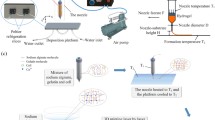Abstract
Gelatin is useful for biofabrication, because it can be used for cell scaffolds and it has unique properties. Therefore, we attempted to fabricate biodevices of gelatin utilizing micro 3D printer which is able to print with high precision. However, it has been difficult to fabricate 3D structure of gelatin utilizing 3D printer, because a printed gelatin droplet on the metal plate electrode would spread before solidification. To clear this problem, we developed a new experimental set-up with a peltier device that can control temperature of the impact point. At an impact point temperature of 80 °C, the spreading of printed gelatin droplets was prevented. Therefore, we were able to print a ball gelatin. In addition, we were able to print a narrower gelatin line than at an impact point temperature of 20 °C.







Similar content being viewed by others
References
Sakaguchi K, Shimizu T, Horaguchi S, et al (2013) In vitro engineering of vascularized tissue surrogates, Sci Rep 3:1316.
Jones AF, Greenhough S, King JA et al (2013) Development of a valve-based cell printer for the formation of human embryonic stem cell spheroid aggregates. Biofabrication 5:015013
Takeuchi S, Garstecki P, Weibel DB et al (2005) An axisymmetric flow-focusing microfluidic device. Adv Mater 17(8):1067–1072
Kikuchi A, Okano T (2005) Nanostructured designs of biomedical materials: applications of cell sheet engineering to functional regenerative tissues and organs. J Controll Rel 101:69–84
Onoe H, Okitsu T, Itou A et al (2013) Metre-long cell-laden microfibres exhibit tissue morphologies and functions. Nat Mater 12:584–590
Yanga J, Yamato M, Kohno C et al (2005) Cell sheet engineering: recreating tissues without biodegradable scaffolds. Biomaterials 26:6415–6422
Asakwa N, Shimizu T, Tsuda Y et al (2010) Pre-vascularization of in vitro three-dimensional tissues created by cell sheet engineering. Biomaterials 31:3903–3909
Haraguchi Y, Shimizu T, Sasagawa T et al (2012) Fabrication of functional three-dimensional tissues by stacking cell sheets in vitro. Nature protocols 7(5):850–858
Kubo H, Shimizua T, Yamato M et al (2007) Creation of myocardial tubes using cardiomyocyte sheets and an in vitro cell sheet-wrapping device. Biomaterials 28:3508–3516
Jain RK, Au P, Tam J et al (2005) Engineering vascularized tissue. Nat Biotechnol 23(7):821–823
Nishiyama Y, Nakamura M, Henmi C et al (2008) Development of a three-dimensional bioprinter: construction of cell supporting structures using hydrogel and state-of-the-art inkjet technology. J Biomech Eng 131:035001
Norotte C, Marga F, Niklason L et al (2009) Scaffold-free vascular tissue engineering using bioprinting. Biomaterials 30(30):5910–5917
Kwon K, Kimb W (2007) A waveform design method for high-speed inkjet printing based on self-sensing measurement. Sens Actuators A 140:75–83
Bertassoni LE, Cecconi M, Manoharan V et al (2014) Hydrogel bioprinted microchannel networks for vascularization of tissue engineering constructs. Lab Chip 14:2202–2211
Nakamura M, Nishiyama Y, Henmi C et al (2008) Ink jet three-dimensional digital fabrication for biological tissue manufacturing: analysis of alginate microgel beads produced by ink jet droplets for three dimensional tissue fabrication. J Imaging Sci Technol 52(6):060201–060206
Tanaka R, Sakaguchi K, Umezu S (2016), Fundamental Printing Characteristics on Gelatin Utilizing Micro 3D Printer. In: Proceedings of AROB 21st 2016: 678–681.
Umezu S, Kitajima T, Ohmori H et al (2011) Fundamental characteristics of printed cell structures utilizing electrostatic inkjet phenomena. Sens Actuators A 166:251–255
Lee A, Watanabe H, Matsumiya Y et al (2014) Dielectric characterization of pigment inks for electrohydrodynamic jet printing. Ind Eng Chem Res 53:17445–17453
Umezu S, Ohmori H (2014) Characteristics on micro-biofabrication by patterning with electrostatically injected droplet. CIRP Ann Manuf Technol 63:221–224
Umezu S, Hatta T, Ohmori H et al (2013) Fundamental characteristics of bioprint on calcium alginate gel. Jpn J Appl Phys 52:05DB20
Umezu S (2014) Precision printing of gelatin utilizing electrostatic inkjet. Jpn J Appl Phys 53:05HC01
Acknowledgements
The authors would like to thank Nitta gelatin Co. for the supply of the gelatin. This work was supported by The Precise Measurement Technology Promotion Foundation, Urakami Foundation for Food and Food Culture Promotion, JSPS Kakenhi Grant Number 254202224, and Waseda University Grants for Special Research Projects (Project Number: 2014S-097).
Author information
Authors and Affiliations
Corresponding author
Additional information
This work was presented in part at the 21st International Symposium on Artificial Life and Robotics, Beppu, Oita, January 20–22, 2016.
About this article
Cite this article
Tanaka, Ri., Sakaguchi, K. & Umezu, S. Fundamental characteristics of printed gelatin utilizing micro 3D printer. Artif Life Robotics 22, 316–320 (2017). https://doi.org/10.1007/s10015-016-0348-8
Received:
Accepted:
Published:
Issue Date:
DOI: https://doi.org/10.1007/s10015-016-0348-8




